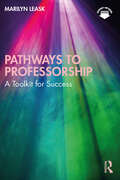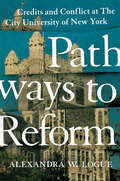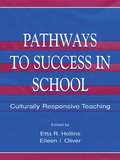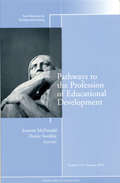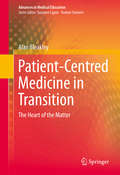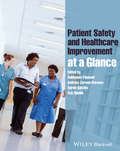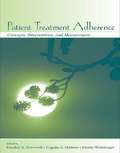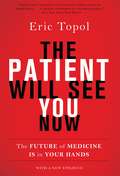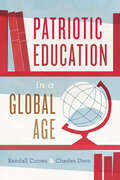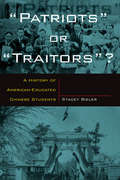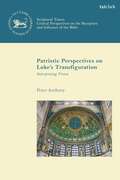- Table View
- List View
Pathways to Professorship: A Toolkit for Success
by Marilyn LeaskPeople who become professors are experts in their field. But how does a new academic, aspiring to become a professor, choose a field of study and plan a career that leads to professorship? This practical book answers this question, guiding aspiring academics step by step through the areas in which they need to demonstrate excellence if they are to gain the international recognition and professional profile which leads to a professorial post. Each chapter highlights real-life, internationally applicable examples of what successful achievements look like and what pitfalls to be aware of. Supported by an international survey of professors and their experiences working within university systems, the chapters outline key topics relevant to any aspiring professor. For example: Criteria for obtaining a professorship Carving out a specialist research niche Establishing an international reputation Advice on getting your research published Undertaking impactful research and winning funding Networking and developing a media presence Balancing research, teaching and your personal life This must-have book is filled with tips and practical advice for building an academic career and is an essential read for anyone looking to better understand routes into professorship.
Pathways to Professorship: A Toolkit for Success
by Marilyn LeaskPeople who become professors are experts in their field. But how does a new academic, aspiring to become a professor, choose a field of study and plan a career that leads to professorship? This practical book answers this question, guiding aspiring academics step by step through the areas in which they need to demonstrate excellence if they are to gain the international recognition and professional profile which leads to a professorial post. Each chapter highlights real-life, internationally applicable examples of what successful achievements look like and what pitfalls to be aware of. Supported by an international survey of professors and their experiences working within university systems, the chapters outline key topics relevant to any aspiring professor. For example: Criteria for obtaining a professorship Carving out a specialist research niche Establishing an international reputation Advice on getting your research published Undertaking impactful research and winning funding Networking and developing a media presence Balancing research, teaching and your personal life This must-have book is filled with tips and practical advice for building an academic career and is an essential read for anyone looking to better understand routes into professorship.
Pathways to Reform: Credits and Conflict at The City University of New York
by Alexandra W. LogueA personal account of the implementation of a controversial credit transfer program at the nation's third-largest universityChange is notoriously difficult in any large organization. Institutions of higher education are no exception. From 2010 to 2013, Alexandra Logue, then chief academic officer of The City University of New York, led a controversial reform initiative known as Pathways. The program aimed to facilitate the transfer of credits among the university’s nineteen constituent colleges in order to improve graduation rates—a long-recognized problem for public universities such as CUNY. Hotly debated, Pathways met with vociferous resistance from many faculty members, drew the attention of local and national media, and resulted in lengthy legal action. In Pathways to Reform, Logue, the figure at the center of the maelstrom, blends vivid personal narrative with an objective perspective to tell how this hard-fought plan was successfully implemented at the third-largest university in the United States.Logue vividly illustrates why change does or does not take place in higher education, and the professional and personal tolls exacted. Looking through the lens of the Pathways program and factoring in key players, she analyzes how governance structures and conflicting interests, along with other institutional factors, impede change—which, Logue shows, is all too rare, slow, and costly. In this environment, she argues, it is shared governance, combined with a strong, central decision-making authority, that best facilitates necessary reform. Logue presents a compelling investigation of not only transfer policy but also power dynamics and university leadership.Shedding light on the inner workings of one of the most important public institutions in the nation, Pathways to Reform provides the first full account of how, despite opposition, a complex higher education initiative was realized.All net royalties received by the author from sales of this book will be donated to The City University of New York to support undergraduate student financial aid.
Pathways to Reform: Credits and Conflict at The City University of New York
by Alexandra W. LogueA personal account of the implementation of a controversial credit transfer program at the nation's third-largest universityChange is notoriously difficult in any large organization. Institutions of higher education are no exception. From 2010 to 2013, Alexandra Logue, then chief academic officer of The City University of New York, led a controversial reform initiative known as Pathways. The program aimed to facilitate the transfer of credits among the university’s nineteen constituent colleges in order to improve graduation rates—a long-recognized problem for public universities such as CUNY. Hotly debated, Pathways met with vociferous resistance from many faculty members, drew the attention of local and national media, and resulted in lengthy legal action. In Pathways to Reform, Logue, the figure at the center of the maelstrom, blends vivid personal narrative with an objective perspective to tell how this hard-fought plan was successfully implemented at the third-largest university in the United States.Logue vividly illustrates why change does or does not take place in higher education, and the professional and personal tolls exacted. Looking through the lens of the Pathways program and factoring in key players, she analyzes how governance structures and conflicting interests, along with other institutional factors, impede change—which, Logue shows, is all too rare, slow, and costly. In this environment, she argues, it is shared governance, combined with a strong, central decision-making authority, that best facilitates necessary reform. Logue presents a compelling investigation of not only transfer policy but also power dynamics and university leadership.Shedding light on the inner workings of one of the most important public institutions in the nation, Pathways to Reform provides the first full account of how, despite opposition, a complex higher education initiative was realized.All net royalties received by the author from sales of this book will be donated to The City University of New York to support undergraduate student financial aid.
Pathways To Success in School: Culturally Responsive Teaching
by Etta R. Hollins Eileen I. OliverThis text is designed to help preservice and in-service teachers identify pathways to productive teaching and learning for students from culturally and experientially diverse backgrounds. To better serve an increasingly diverse population, teachers need to be competent in selecting and developing culturally responsive curricula and instructional approaches that better facilitate learning for all students. They must be able to attend to diversity within and across cultural groups, and validate students' cultural knowledge acquired outside the classroom. To provide equitable access to learning, they must be able to strategically select or develop instructional approaches that build upon their students' learning propensities, cognitive schemata, experiential backgrounds, and perceptions. The chapter authors in this text present ways of understanding ones' own thinking (metacognition), and ways of thinking about teaching and learning situations and constructing productive strategies. The reader is engaged in: *Learning about the context in which he or she will practice, *Understanding key aspects of student's cultural and experiential background and learning preferences, *Exploring ways to bring these factors together in framing and selecting meaningful curriculum content and learning experiences. The volume is organized into three interrelated sections: Part I presents two approaches to becoming a competent practitioner; Part II offers approaches to developing and using culturally relevant pedagogy; Part III addresses curriculum content and design. Helpful pedagogical features are included to facilitate its use as a textbook: Each of the three main parts begins with an overview that provides an introduction and summary of the main ideas addressed and the relationship among ideas presented by different authors; each chapter opens with focus questions and concludes with suggested learning experiences; chapter-end references may be used to expand the reader's knowledge in specific areas.
Pathways To Success in School: Culturally Responsive Teaching
by Etta R. Hollins Eileen I. OliverThis text is designed to help preservice and in-service teachers identify pathways to productive teaching and learning for students from culturally and experientially diverse backgrounds. To better serve an increasingly diverse population, teachers need to be competent in selecting and developing culturally responsive curricula and instructional approaches that better facilitate learning for all students. They must be able to attend to diversity within and across cultural groups, and validate students' cultural knowledge acquired outside the classroom. To provide equitable access to learning, they must be able to strategically select or develop instructional approaches that build upon their students' learning propensities, cognitive schemata, experiential backgrounds, and perceptions. The chapter authors in this text present ways of understanding ones' own thinking (metacognition), and ways of thinking about teaching and learning situations and constructing productive strategies. The reader is engaged in: *Learning about the context in which he or she will practice, *Understanding key aspects of student's cultural and experiential background and learning preferences, *Exploring ways to bring these factors together in framing and selecting meaningful curriculum content and learning experiences. The volume is organized into three interrelated sections: Part I presents two approaches to becoming a competent practitioner; Part II offers approaches to developing and using culturally relevant pedagogy; Part III addresses curriculum content and design. Helpful pedagogical features are included to facilitate its use as a textbook: Each of the three main parts begins with an overview that provides an introduction and summary of the main ideas addressed and the relationship among ideas presented by different authors; each chapter opens with focus questions and concludes with suggested learning experiences; chapter-end references may be used to expand the reader's knowledge in specific areas.
Pathways to the Profession of Educational Development: New Directions for Teaching and Learning, Number 122 (J-B TL Single Issue Teaching and Learning #137)
by Jeanette McDonald Denise StockleyThe contributors to this volume are academics working directly or indirectly with teaching and learning centers and professional communities, serving in the capacity of educational developer, researcher, or specialist; unit manager or director; or senior administrator. Drawing on survey and interview data, individual experience or perspective, and familiarity with the educational literature, they offer a context to understand and appreciate how the field of educational development, developer practice, and individual pathways have evolved, further highlighting what territory remains to be explored and uncovered. Over the last fifty years, educational development has evolved from an informal set of instructional improvement activities championed by individuals to a scholarly field of study and practice that aims to advance teaching and learning at the individual, institutional and (more recently) sector levels. During this time, educational development work has moved from the fringes to the mainstream of the higher education landscape, bringing to the community a diverse group of dedicated academic professionals. This volume draws on their experience and insight to provide an invaluable guide to future challenges and issues. This is the 122nd volume of the Jossey-Bass higher education quarterly report series New Directions for Teaching and Learning, which offers a comprehensive range of ideas and techniques for improving college teaching based on the experience of seasoned instructors and the latest findings of educational and psychological researchers.
Pathways to the Profession of Educational Development: New Directions for Teaching and Learning, Number 122 (J-B TL Single Issue Teaching and Learning #136)
by Jeanette McDonald Denise StockleyThe contributors to this volume are academics working directly or indirectly with teaching and learning centers and professional communities, serving in the capacity of educational developer, researcher, or specialist; unit manager or director; or senior administrator. Drawing on survey and interview data, individual experience or perspective, and familiarity with the educational literature, they offer a context to understand and appreciate how the field of educational development, developer practice, and individual pathways have evolved, further highlighting what territory remains to be explored and uncovered. Over the last fifty years, educational development has evolved from an informal set of instructional improvement activities championed by individuals to a scholarly field of study and practice that aims to advance teaching and learning at the individual, institutional and (more recently) sector levels. During this time, educational development work has moved from the fringes to the mainstream of the higher education landscape, bringing to the community a diverse group of dedicated academic professionals. This volume draws on their experience and insight to provide an invaluable guide to future challenges and issues. This is the 122nd volume of the Jossey-Bass higher education quarterly report series New Directions for Teaching and Learning, which offers a comprehensive range of ideas and techniques for improving college teaching based on the experience of seasoned instructors and the latest findings of educational and psychological researchers.
Patient-Centred Medicine in Transition: The Heart of the Matter (Advances in Medical Education #3)
by Alan BleakleyThis book challenges functional models for more aesthetic and ethical models, where communication is grounded in values systems of cultures. Here, communication is treated as a distributed phenomenon involving networks of persons, activities and artifacts, and extends beyond doctor-patient relationships to working in and across teams around patients. The purpose of the book is to stimulate thinking about how patient care and safety may be improved through a focus upon the ‘non-technical’ work of doctors – interpersonal communication, teamwork and situation awareness in teams. The focus is then not on the personality of the doctor, but on the dynamics of relationships which form doctors’ multiple identities.
Patient Safety and Healthcare Improvement at a Glance (At a Glance)
by Sukhmeet Panesar Andrew Carson-Stevens Sarah Salvilla Aziz SheikhPatient Safety and Healthcare Improvement at a Glance is a timely and thorough overview of healthcare quality written specifically for students and junior doctors and healthcare professionals. It bridges the gap between the practical and the theoretical to ensure the safety and wellbeing of patients. Featuring essential step-by-step guides to interpreting and managing risk, quality improvement within clinical specialties, and practice development, this highly visual textbook offers the best preparation for the increased emphasis on patient safety and quality-driven focus in today’s healthcare environment. Healthcare Improvement and Safety at a Glance: • Maps out and follows the World Health Organization Patient Safety curriculum • Draws upon the quality improvement work of the Institute for Healthcare Improvement This practical guide, covering a vital topic of increasing importance in healthcare, provides the first genuine introduction to patient safety and quality improvement grounded in clinical practice.
Patient Treatment Adherence: Concepts, Interventions, and Measurement
by Hayden B. Bosworth Eugene Z. Oddone Morris WeinbergerThis new book summarizes the adherence literature for a number of specific health behaviors and populations. It provides a comprehensive source on the conceptualization, interventions, and measurement of treatment adherence and a synthesis of the research across demographic and chronic diseases. The text presents problems associated with treatment adherence; theoretical models that have commonly been used to understand, predict, and/or improve adherence; adherence with specific behaviors including exercise, diet, rehabilitation, medication, and psychological therapies; and strategies in enhancing adherence.Because chronic diseases involve similar behaviors, the handbook is organized by specific behaviors and special populations, and not by disease. Every chapter is sub-organized by specific diseases to ensure easy access for the readers and features a discussion of adherence across demographic and chronic conditions, a review of previous interventions directed at the particular behavior or population, questions and scoring algorithms for widely used measures of treatment adherence, a discussion of the clinical research, and where appropriate, policy implications. Patient Treatment Adherence addresses: practical recommendations to improve adherence; the impact of non-adherence including costs and health-related quality of life; methodological issues such as assessing cost-effectiveness; and the use of technological advances to improve adherence.Intended for health service professionals, health, clinical, social, and cognitive psychologists, primary care physicians, pharmacists, and policy-makers, this text is also an excellent resource for graduate courses on health psychology and public health.
Patient Treatment Adherence: Concepts, Interventions, and Measurement
by Hayden B. Bosworth Eugene Z. Oddone Morris WeinbergerThis new book summarizes the adherence literature for a number of specific health behaviors and populations. It provides a comprehensive source on the conceptualization, interventions, and measurement of treatment adherence and a synthesis of the research across demographic and chronic diseases. The text presents problems associated with treatment adherence; theoretical models that have commonly been used to understand, predict, and/or improve adherence; adherence with specific behaviors including exercise, diet, rehabilitation, medication, and psychological therapies; and strategies in enhancing adherence.Because chronic diseases involve similar behaviors, the handbook is organized by specific behaviors and special populations, and not by disease. Every chapter is sub-organized by specific diseases to ensure easy access for the readers and features a discussion of adherence across demographic and chronic conditions, a review of previous interventions directed at the particular behavior or population, questions and scoring algorithms for widely used measures of treatment adherence, a discussion of the clinical research, and where appropriate, policy implications. Patient Treatment Adherence addresses: practical recommendations to improve adherence; the impact of non-adherence including costs and health-related quality of life; methodological issues such as assessing cost-effectiveness; and the use of technological advances to improve adherence.Intended for health service professionals, health, clinical, social, and cognitive psychologists, primary care physicians, pharmacists, and policy-makers, this text is also an excellent resource for graduate courses on health psychology and public health.
The Patient Will See You Now: The Future of Medicine Is in Your Hands
by Eric TopolThe essential guide by one of America's leading doctors to how digital technology enables all of us to take charge of our health A trip to the doctor is almost a guarantee of misery. You'll make an appointment months in advance. You'll probably wait for several hours until you hear "the doctor will see you now"-but only for fifteen minutes! Then you'll wait even longer for lab tests, the results of which you'll likely never see, unless they indicate further (and more invasive) tests, most of which will probably prove unnecessary (much like physicals themselves). And your bill will be astronomical.In The Patient Will See You Now, Eric Topol, one of the nation's top physicians, shows why medicine does not have to be that way. Instead, you could use your smartphone to get rapid test results from one drop of blood, monitor your vital signs both day and night, and use an artificially intelligent algorithm to receive a diagnosis without having to see a doctor, all at a small fraction of the cost imposed by our modern healthcare system.The change is powered by what Topol calls medicine's "Gutenberg moment." Much as the printing press took learning out of the hands of a priestly class, the mobile internet is doing the same for medicine, giving us unprecedented control over our healthcare. With smartphones in hand, we are no longer beholden to an impersonal and paternalistic system in which "doctor knows best." Medicine has been digitized, Topol argues; now it will be democratized. Computers will replace physicians for many diagnostic tasks, citizen science will give rise to citizen medicine, and enormous data sets will give us new means to attack conditions that have long been incurable. Massive, open, online medicine, where diagnostics are done by Facebook-like comparisons of medical profiles, will enable real-time, real-world research on massive populations. There's no doubt the path forward will be complicated: the medical establishment will resist these changes, and digitized medicine inevitably raises serious issues surrounding privacy. Nevertheless, the result-better, cheaper, and more human health care-will be worth it.Provocative and engrossing, The Patient Will See You Now is essential reading for anyone who thinks they deserve better health care. That is, for all of us.
The Patient Will See You Now: The Future of Medicine Is in Your Hands
by Eric TopolThe essential guide by one of America's leading doctors to how digital technology enables all of us to take charge of our health A trip to the doctor is almost a guarantee of misery. You'll make an appointment months in advance. You'll probably wait for several hours until you hear "the doctor will see you now"-but only for fifteen minutes! Then you'll wait even longer for lab tests, the results of which you'll likely never see, unless they indicate further (and more invasive) tests, most of which will probably prove unnecessary (much like physicals themselves). And your bill will be astronomical. In The Patient Will See You Now, Eric Topol, one of the nation's top physicians, shows why medicine does not have to be that way. Instead, you could use your smartphone to get rapid test results from one drop of blood, monitor your vital signs both day and night, and use an artificially intelligent algorithm to receive a diagnosis without having to see a doctor, all at a small fraction of the cost imposed by our modern healthcare system. The change is powered by what Topol calls medicine's "Gutenberg moment." Much as the printing press took learning out of the hands of a priestly class, the mobile internet is doing the same for medicine, giving us unprecedented control over our healthcare. With smartphones in hand, we are no longer beholden to an impersonal and paternalistic system in which "doctor knows best." Medicine has been digitized, Topol argues; now it will be democratized. Computers will replace physicians for many diagnostic tasks, citizen science will give rise to citizen medicine, and enormous data sets will give us new means to attack conditions that have long been incurable. Massive, open, online medicine, where diagnostics are done by Facebook-like comparisons of medical profiles, will enable real-time, real-world research on massive populations. There's no doubt the path forward will be complicated: the medical establishment will resist these changes, and digitized medicine inevitably raises serious issues surrounding privacy. Nevertheless, the result-better, cheaper, and more human health care-will be worth it. Provocative and engrossing, The Patient Will See You Now is essential reading for anyone who thinks they deserve better health care. That is, for all of us.
Patrick Heron
by Andrew Wilson Sara MatsonPublished to accompany the first major Patrick Heron retrospective in two decades, this book will feature the best of Heron’s paintings, from the 1940s to his late career, alongside thought-provoking text.
Patriotic Education in a Global Age (History and Philosophy of Education Series)
by Randall Curren Charles DornShould schools attempt to cultivate patriotism? If so, why? And what conception of patriotism should drive those efforts? Is patriotism essential to preserving national unity, sustaining vigorous commitment to just institutions, or motivating national service? Are the hazards of patriotism so great as to overshadow its potential benefits? Is there a genuinely virtuous form of patriotism that societies and schools should strive to cultivate? In Patriotic Education in a Global Age, philosopher Randall Curren and historian Charles Dorn address these questions as they seek to understand what role patriotism might legitimately play in schools as an aspect of civic education. They trace the aims and rationales that have guided the inculcation of patriotism in American schools over the years, the methods by which schools have sought to cultivate patriotism, and the conceptions of patriotism at work in those aims, rationales, and methods. They then examine what those conceptions mean for justice, education, and human flourishing. Though the history of attempts to cultivate patriotism in schools offers both positive and cautionary lessons, Curren and Dorn ultimately argue that a civic education organized around three components of civic virtue—intelligence, friendship, and competence—and an inclusive and enabling school community can contribute to the development of a virtuous form of patriotism that is compatible with equal citizenship, reasoned dissent, global justice, and devotion to the health of democratic institutions and the natural environment. Patriotic Education in a Global Age mounts a spirited defense of democratic institutions as it situates an understanding of patriotism in the context of nationalist, populist, and authoritarian movements in the United States and Europe, and will be of interest to anyone concerned about polarization in public life and the future of democracy.
Patriotic Education in a Global Age (History and Philosophy of Education Series)
by Randall Curren Charles DornShould schools attempt to cultivate patriotism? If so, why? And what conception of patriotism should drive those efforts? Is patriotism essential to preserving national unity, sustaining vigorous commitment to just institutions, or motivating national service? Are the hazards of patriotism so great as to overshadow its potential benefits? Is there a genuinely virtuous form of patriotism that societies and schools should strive to cultivate? In Patriotic Education in a Global Age, philosopher Randall Curren and historian Charles Dorn address these questions as they seek to understand what role patriotism might legitimately play in schools as an aspect of civic education. They trace the aims and rationales that have guided the inculcation of patriotism in American schools over the years, the methods by which schools have sought to cultivate patriotism, and the conceptions of patriotism at work in those aims, rationales, and methods. They then examine what those conceptions mean for justice, education, and human flourishing. Though the history of attempts to cultivate patriotism in schools offers both positive and cautionary lessons, Curren and Dorn ultimately argue that a civic education organized around three components of civic virtue—intelligence, friendship, and competence—and an inclusive and enabling school community can contribute to the development of a virtuous form of patriotism that is compatible with equal citizenship, reasoned dissent, global justice, and devotion to the health of democratic institutions and the natural environment. Patriotic Education in a Global Age mounts a spirited defense of democratic institutions as it situates an understanding of patriotism in the context of nationalist, populist, and authoritarian movements in the United States and Europe, and will be of interest to anyone concerned about polarization in public life and the future of democracy.
Patriotic Education in a Global Age (History and Philosophy of Education Series)
by Randall Curren Charles DornShould schools attempt to cultivate patriotism? If so, why? And what conception of patriotism should drive those efforts? Is patriotism essential to preserving national unity, sustaining vigorous commitment to just institutions, or motivating national service? Are the hazards of patriotism so great as to overshadow its potential benefits? Is there a genuinely virtuous form of patriotism that societies and schools should strive to cultivate? In Patriotic Education in a Global Age, philosopher Randall Curren and historian Charles Dorn address these questions as they seek to understand what role patriotism might legitimately play in schools as an aspect of civic education. They trace the aims and rationales that have guided the inculcation of patriotism in American schools over the years, the methods by which schools have sought to cultivate patriotism, and the conceptions of patriotism at work in those aims, rationales, and methods. They then examine what those conceptions mean for justice, education, and human flourishing. Though the history of attempts to cultivate patriotism in schools offers both positive and cautionary lessons, Curren and Dorn ultimately argue that a civic education organized around three components of civic virtue—intelligence, friendship, and competence—and an inclusive and enabling school community can contribute to the development of a virtuous form of patriotism that is compatible with equal citizenship, reasoned dissent, global justice, and devotion to the health of democratic institutions and the natural environment. Patriotic Education in a Global Age mounts a spirited defense of democratic institutions as it situates an understanding of patriotism in the context of nationalist, populist, and authoritarian movements in the United States and Europe, and will be of interest to anyone concerned about polarization in public life and the future of democracy.
Patriotic Education in a Global Age (History and Philosophy of Education Series)
by Randall Curren Charles DornShould schools attempt to cultivate patriotism? If so, why? And what conception of patriotism should drive those efforts? Is patriotism essential to preserving national unity, sustaining vigorous commitment to just institutions, or motivating national service? Are the hazards of patriotism so great as to overshadow its potential benefits? Is there a genuinely virtuous form of patriotism that societies and schools should strive to cultivate? In Patriotic Education in a Global Age, philosopher Randall Curren and historian Charles Dorn address these questions as they seek to understand what role patriotism might legitimately play in schools as an aspect of civic education. They trace the aims and rationales that have guided the inculcation of patriotism in American schools over the years, the methods by which schools have sought to cultivate patriotism, and the conceptions of patriotism at work in those aims, rationales, and methods. They then examine what those conceptions mean for justice, education, and human flourishing. Though the history of attempts to cultivate patriotism in schools offers both positive and cautionary lessons, Curren and Dorn ultimately argue that a civic education organized around three components of civic virtue—intelligence, friendship, and competence—and an inclusive and enabling school community can contribute to the development of a virtuous form of patriotism that is compatible with equal citizenship, reasoned dissent, global justice, and devotion to the health of democratic institutions and the natural environment. Patriotic Education in a Global Age mounts a spirited defense of democratic institutions as it situates an understanding of patriotism in the context of nationalist, populist, and authoritarian movements in the United States and Europe, and will be of interest to anyone concerned about polarization in public life and the future of democracy.
Patriotic Education in a Global Age (History and Philosophy of Education Series)
by Randall Curren Charles DornShould schools attempt to cultivate patriotism? If so, why? And what conception of patriotism should drive those efforts? Is patriotism essential to preserving national unity, sustaining vigorous commitment to just institutions, or motivating national service? Are the hazards of patriotism so great as to overshadow its potential benefits? Is there a genuinely virtuous form of patriotism that societies and schools should strive to cultivate? In Patriotic Education in a Global Age, philosopher Randall Curren and historian Charles Dorn address these questions as they seek to understand what role patriotism might legitimately play in schools as an aspect of civic education. They trace the aims and rationales that have guided the inculcation of patriotism in American schools over the years, the methods by which schools have sought to cultivate patriotism, and the conceptions of patriotism at work in those aims, rationales, and methods. They then examine what those conceptions mean for justice, education, and human flourishing. Though the history of attempts to cultivate patriotism in schools offers both positive and cautionary lessons, Curren and Dorn ultimately argue that a civic education organized around three components of civic virtue—intelligence, friendship, and competence—and an inclusive and enabling school community can contribute to the development of a virtuous form of patriotism that is compatible with equal citizenship, reasoned dissent, global justice, and devotion to the health of democratic institutions and the natural environment. Patriotic Education in a Global Age mounts a spirited defense of democratic institutions as it situates an understanding of patriotism in the context of nationalist, populist, and authoritarian movements in the United States and Europe, and will be of interest to anyone concerned about polarization in public life and the future of democracy.
Patriotic Education in a Global Age (History and Philosophy of Education Series)
by Randall Curren Charles DornShould schools attempt to cultivate patriotism? If so, why? And what conception of patriotism should drive those efforts? Is patriotism essential to preserving national unity, sustaining vigorous commitment to just institutions, or motivating national service? Are the hazards of patriotism so great as to overshadow its potential benefits? Is there a genuinely virtuous form of patriotism that societies and schools should strive to cultivate? In Patriotic Education in a Global Age, philosopher Randall Curren and historian Charles Dorn address these questions as they seek to understand what role patriotism might legitimately play in schools as an aspect of civic education. They trace the aims and rationales that have guided the inculcation of patriotism in American schools over the years, the methods by which schools have sought to cultivate patriotism, and the conceptions of patriotism at work in those aims, rationales, and methods. They then examine what those conceptions mean for justice, education, and human flourishing. Though the history of attempts to cultivate patriotism in schools offers both positive and cautionary lessons, Curren and Dorn ultimately argue that a civic education organized around three components of civic virtue—intelligence, friendship, and competence—and an inclusive and enabling school community can contribute to the development of a virtuous form of patriotism that is compatible with equal citizenship, reasoned dissent, global justice, and devotion to the health of democratic institutions and the natural environment. Patriotic Education in a Global Age mounts a spirited defense of democratic institutions as it situates an understanding of patriotism in the context of nationalist, populist, and authoritarian movements in the United States and Europe, and will be of interest to anyone concerned about polarization in public life and the future of democracy.
Patriots or Traitors: A History of American Educated Chinese Students
by Stacey BielerThis title sxplores the love-hate relationship between the USA and China through the experience of Chinese students caught between the two countries. The book sheds light on China's ambivelance towards the Western influence, and the use of educational and cultural exhanges as a political device.
Patriots or Traitors: A History of American Educated Chinese Students
by Stacey BielerThis title sxplores the love-hate relationship between the USA and China through the experience of Chinese students caught between the two countries. The book sheds light on China's ambivelance towards the Western influence, and the use of educational and cultural exhanges as a political device.
Patristic Perspectives on Luke’s Transfiguration: Interpreting Vision (The Library of New Testament Studies)
by Peter AnthonyPeter Anthony explores how visionary elements in Luke's Gospel had a particular influence on early interpretation of the Transfiguration, by examining the rich hermeneutical traditions that emerged - particularly in the Latin West - as the Transfiguration was first depicted visually in art.Anthony begins by comparing the visual and visionary culture of antiquity with that of the present, and their differing interpretations of the Transfiguration. He then examines the Transfiguration texts in the synoptic gospels and their interpretation in modern scholarship, and the reception of the Transfiguration in 2 Peter, the Apocalypse of Peter and the Acts of Peter, Tertullian and Origen. Proceeding to look at interpretations found in the Greek East and the Latin West, Anthony finally discusses the earliest visual depictions of the Transfiguration from the sixth century onward, drawn from a wealth of different art forms. Anthony concludes that early commentators' and artists' understanding of how we see and visualise, and therefore, how the Transfiguration was apprehended, is closer to that of the writers of the New Testament than many modern interpreters' is.
Patristic Perspectives on Luke’s Transfiguration: Interpreting Vision (The Library of New Testament Studies)
by Peter AnthonyPeter Anthony explores how visionary elements in Luke's Gospel had a particular influence on early interpretation of the Transfiguration, by examining the rich hermeneutical traditions that emerged - particularly in the Latin West - as the Transfiguration was first depicted visually in art.Anthony begins by comparing the visual and visionary culture of antiquity with that of the present, and their differing interpretations of the Transfiguration. He then examines the Transfiguration texts in the synoptic gospels and their interpretation in modern scholarship, and the reception of the Transfiguration in 2 Peter, the Apocalypse of Peter and the Acts of Peter, Tertullian and Origen. Proceeding to look at interpretations found in the Greek East and the Latin West, Anthony finally discusses the earliest visual depictions of the Transfiguration from the sixth century onward, drawn from a wealth of different art forms. Anthony concludes that early commentators' and artists' understanding of how we see and visualise, and therefore, how the Transfiguration was apprehended, is closer to that of the writers of the New Testament than many modern interpreters' is.
